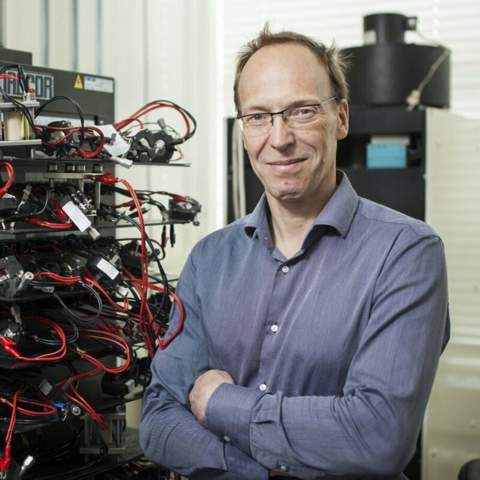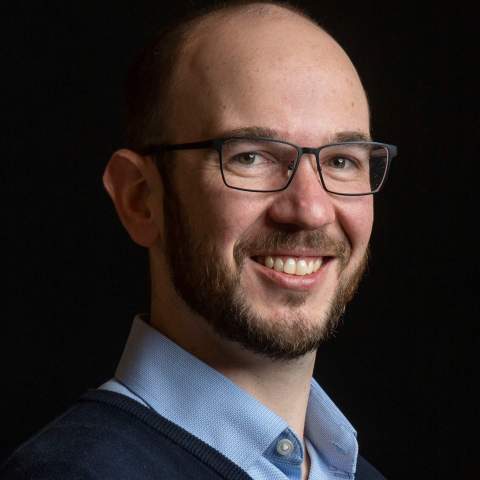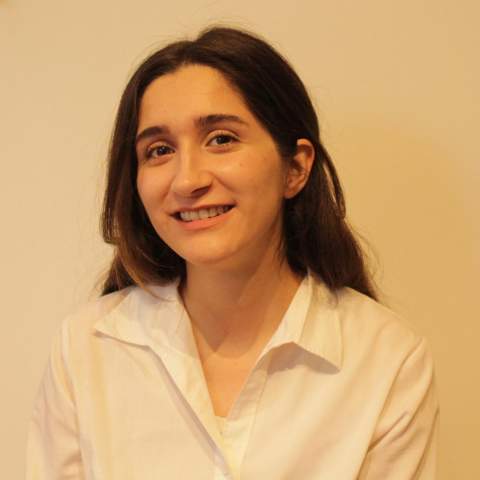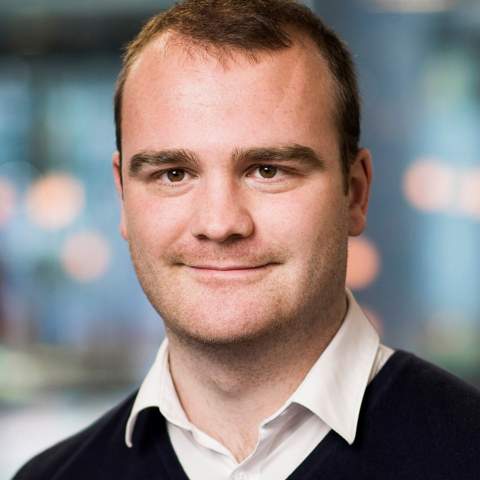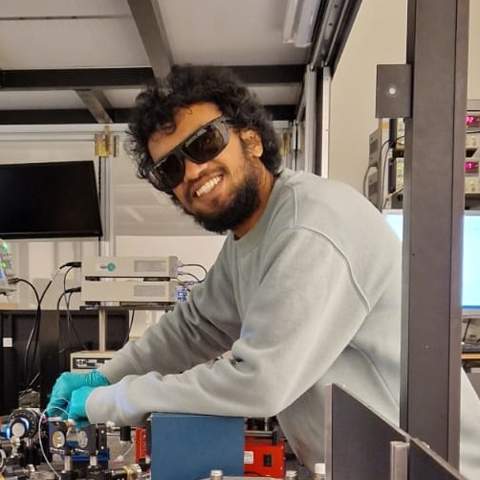Advanced In Situ Methods for Materials Characterization
Structural characterization of materials down to the atomic scale is essential for understanding properties and performances of materials. The holy grail is to perform at the same time advanced structural and property characterization under realistic dynamic conditions. Recent technological advancements now allow us approaching this holy grail.

Header image: Bart Kooi placing a sample in his transmission electron microscope.
Photo by Leoni von Ristok
In the present (afternoon) workshop the main focus is on the use of structural probes based on electrons, X-rays (lab-based or synchrotron) and neutrons and then perform in-situ or operando dynamical experiments. This for instance allows atomic resolution imaging of nanoscale electronic devices subjected to electrical fields, light driven processes monitored inside the electron microscope, nanoscale catalysts interacting with gases and liquids and operando studies of battery materials.
Welcome & introduction
By Arjan Mol (Scientific Director 4TU.HTM, and Professor Corrosion Technology & Electrochemistry at the Department of Materials Science and Engineering, Mechanical Engineering, Delft Univerity of Technology) and Bart Kooi (Professor Nanostructured Materials and Interfaces, Zernike Institute for Advanced Materials, University of Groningen).

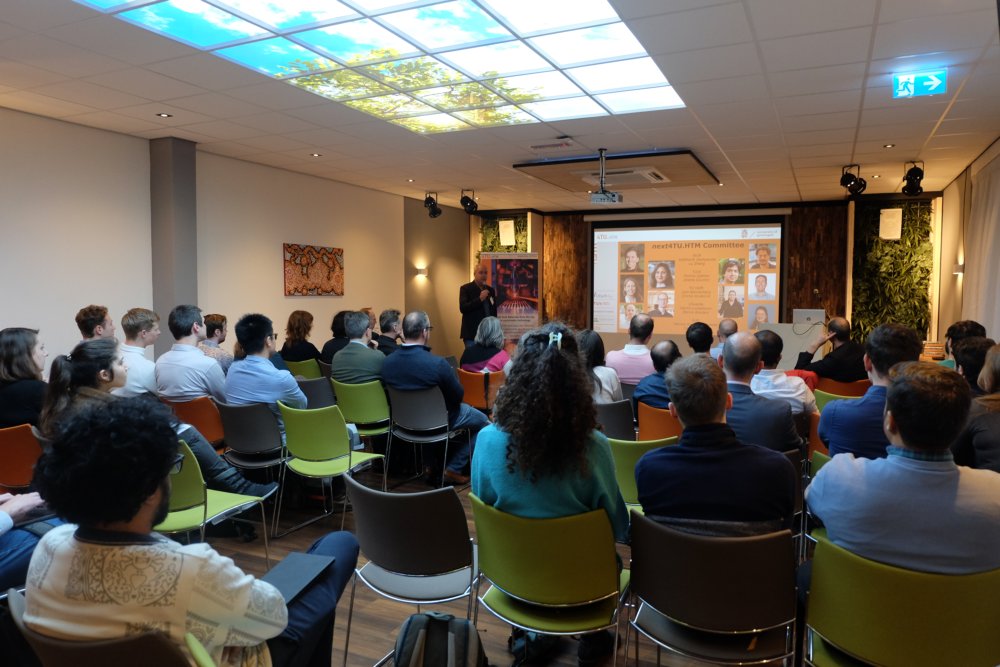
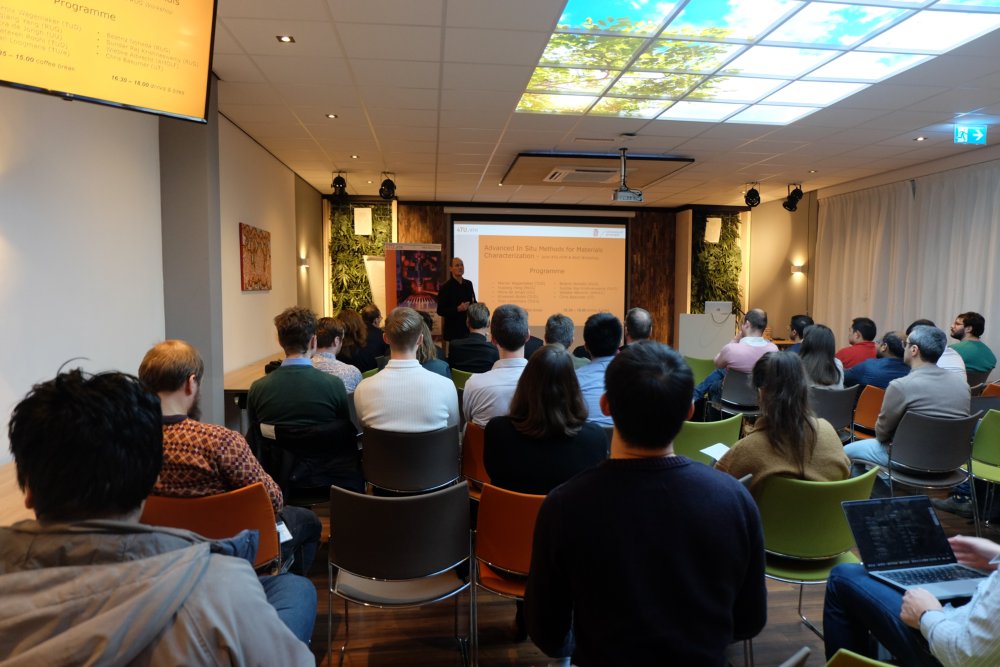
Invited speakers
- Prof. Marnix Wagemaker
Professor and head of the section Storage of Electrochemical Energy (SEE), Radiation Science & Technology, Faculty of Applied Science, Delft University of Technology.


- Prof. Petra de Jongh
Leader the Materials Chemistry and Catalysis group at the Debye Institute for Nanomaterials Science, Utrecht University and PI in the RELEASE, BATTERYNL, and ANION Consortia.
(Photo by Ed van Rijswijk)
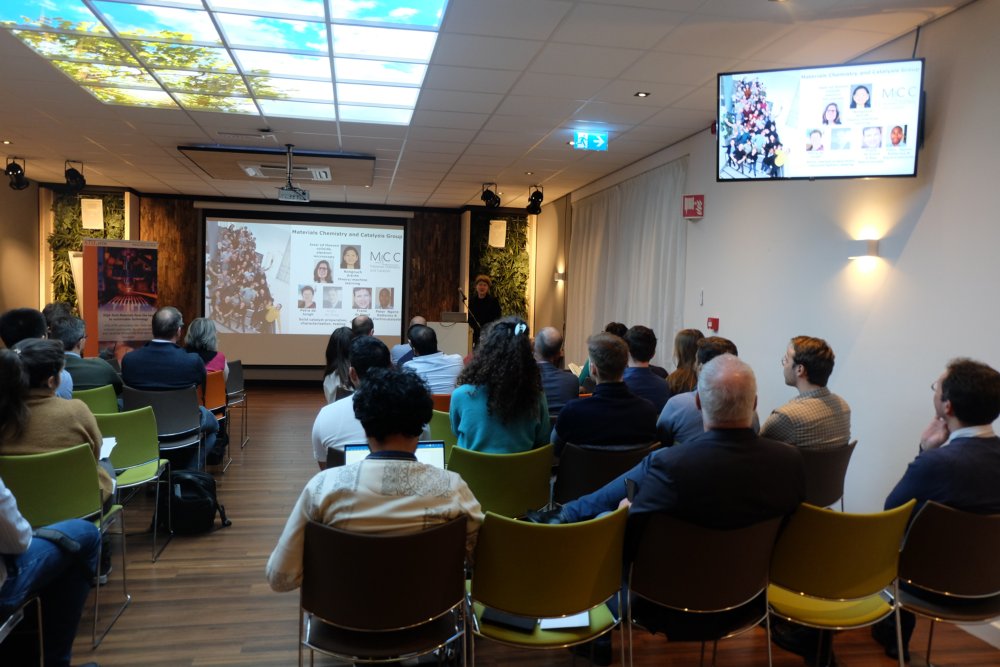

- Prof. Beatriz Noheda
Leader Solid State Materials for Electronics group, Zernike Institute, and Scientific Director CogniGron

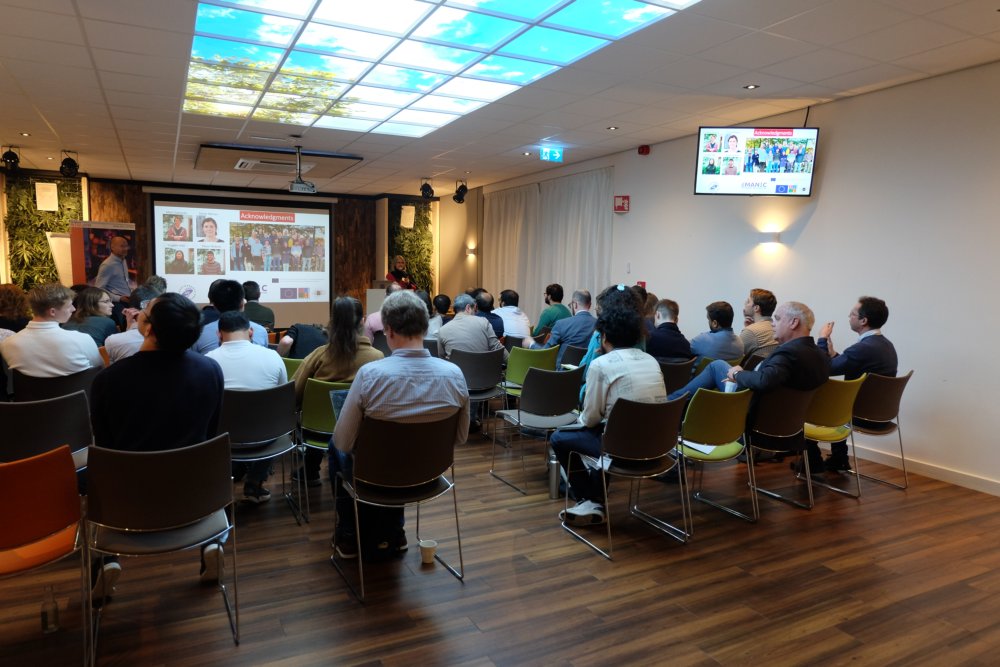
- Dr. Wiebke Albrecht
Group leader Hybrid Nanosystems at Amolf, Amsterdam


- Dr. Chris Baeumer
Associate Professor in the Inorganic Materials Science group at the MESA+ Institute of Technology at the University of Twente, and scientific co-leader of the operando HAXPES user facility.


Information - Invited speakers
Marnix Wagemaker
 Professor Marnix Wagemaker is Head of the section Storage of Electrochemical Energy (SEE), Radiation Science & Technology, Delft University of Technology
Professor Marnix Wagemaker is Head of the section Storage of Electrochemical Energy (SEE), Radiation Science & Technology, Delft University of Technology
Title: Guiding next generation battery material design through operando characterizations
Abstract
Electrification of our mobility and balancing a solar-wind dominant electrical grid requires efficient energy storage. For this batteries are key technology, however, many challenges need to be addressed including independence of rare and critical elements, better performances towards different applications (i.e. storage to enable mobility versus stationary), safety and circularity. This requires the development of next generation battery anodes, cathodes and electrolyte materials. Both for existing, promising battery materials as well as for novel battery chemistries, the shared challenge is to prevent degradation upon repeated charge and discharge cycles, which prevents these to reach the market. In this presentation I will illustrate how operando techniques provide insight in the failure mechanisms, guiding the development of improved materials. Firstly, operando NMR and operando Neutron Depth Profiling is utilized to investigate ultra-high-capacity Li-metal anodes, guiding the design of novel electrolytes. Secondly, with operando microbeam X-ray diffraction we gain unique insights in the ensemble behaviour of electrode particles, providing a different perspective on battery material failure and performance limitations.
References
[1] The lasting impact of formation cycling on the Li-ion kinetics between SEI and the Li-metal anode and its correlation with efficiency. Shengnan Zhang, Yuhang Li, Lars J. Bannenberg, Ming Liu , Swapna Ganapathy and Marnix Wagemaker Science Advances 2024 doi:10.1126/sciadv.adj8889
[2] Entropy-Driven Liquid Electrolytes for Lithium Batteries. Qidi Wang, Chenglong Zhao Swapna Ganapathy and Marnix Wagemaker et al. Advanced Materials 2023 doi:10.1002/adma.202210677 and Nature Comm. 2023 doi:10.1038/s41467-023-36075-1
[3] Kinetically Induced Memory Effect in Li-ion Batteries. Pierfrancesco Ombrini, Qidi Wang, Alexandros Vasileiadis, Fangting Wu, Ziyao Gao, Xia Hu, Martijn van Hulzen, Baohua Li, Chenglong Zhao and Marnix Wagemaker. 2024 ChemRxiv doi:10.26434/chemrxiv-2024-ctxkm
Petra de Jongh
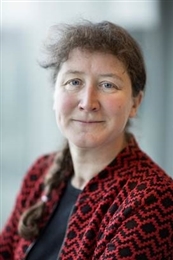 Professor Petra de Jongh is leader of the Materials Chemistry and Catalysis group at the Debye Institute for Nanomaterials Science, Utrecht University and PI in the RELEASE, BATTERYNL, and ANION Consortia.
Professor Petra de Jongh is leader of the Materials Chemistry and Catalysis group at the Debye Institute for Nanomaterials Science, Utrecht University and PI in the RELEASE, BATTERYNL, and ANION Consortia.
Title: Observing nanoparticulate catalysts at work
Abstract
To enable the energy transition, the rational design of new catalysts to produce circular and sustainable fuels and chemical building blocks is crucial. The most important class of solid catalysts are supported metal nanoparticles, but correlating nanoscale material properties to macroscopic observations of catalyst performance is challenging. Recent developments in gas-cell transmission electron microscopy, also at the Electron Microscopy Centre of Utrecht University, now allow direct, nanoscale imaging of catalysts during reaction. In my talk I will highlight two recent examples, assemblies of Ni-Cu nanoparticles catalysing the decomposition of methane to valuable carbon nanostructures and CO2-free hydrogen, and Ni nanoparticles catalysing the conversion of CO2 and H2 to fuels. Especially relevant is the quantitative coupling that was achieved between macroscopic studies in the reactor and the nanoscale in-situ studies, uniquely allowing insight into the effect of metal nanoparticle size, shape, composition on activity and the particle growth mechanisms which are a common cause of activity loss for supported metal nanocatalysts.
References
- Balancing act: influence of Cu content in NiCu/C catalysts for methane decomposition, S.E. Schoemaker, S. Bismeijer, ….T.A.J. Welling, P.E.de Jongh, Mater. Adv. 5 (10), 4251-4261 (2024).
- In situ analysis of gas dependent redistribution kinetics in bimetallic Au-Pd nanoparticles, M. Perxés Perich, C.R. O’Connor, …P.E. de Jongh, J.E.S. van der Hoeven, J. Mater. Chem. A in press (2024).Science, 372, 630-635 (2021).
- Carbon Nanofiber Growth Rates on NiCu Catalysts: Quantitative Coupling of Macroscopic and Nanoscale In Situ Studies, T.A.J. Welling, S.E. Schoemaker, K.P. de Jong, P.E. de Jongh, J. Phys. Chem. C 127(32), 15766-15774 (2023).
- Direct Observation of Ni Nanoparticle Growth in Carbon-Supported Nickel under Carbon Dioxide Hydrogenation Atmosphere, N.L. Visser, S.J. Turner, …. J.E.S. van der Hoeven, P.E. de Jongh, ACS Nano 17(15), 14963-14973 (2023).
- An In Situ TEM Study of the Influence of Water Vapor on Reduction of Nickel Phyllosilicate – Retarded Growth of Metal Nanoparticles at Higher Rates, S.J. Turner, N.L. Visser, …. P.E. de Jongh, K.P de Jong, Small 20(32), 2401009 (2024).
Beatriz Noheda
 Professor Beatriz Noheda is leader of the Solid State Materials for Electronics group at the Zernike Institute of Advanced Materials, University of Groningen, and Scientific Director of the Groningen Cognitive Systems and Materials center (CogniGron)
Professor Beatriz Noheda is leader of the Solid State Materials for Electronics group at the Zernike Institute of Advanced Materials, University of Groningen, and Scientific Director of the Groningen Cognitive Systems and Materials center (CogniGron)
Title: The many phases of Hafnia under the microscope
Abstract
Hafnia (HfO2) has become extremely popular. Since the beginning of the millennium, amorphous hafnia is used as gate oxide in transistors, allowing to achieve extreme miniaturization. Totally unexpectedly, in 2011, crystalline doped HfO2 was discovered to be ferroelectric at the nanoscale. Despite ferroelectrics displaying faster and more energy efficient switching than other types of materials, somewhere along the way, they lost the race against magnetic and phase change memories, due to issues with miniaturization: for about three decades the ferroelectrics community has tried to look for ways to avoid depolarization fields at the nanoscale. How does a seemingly simple material like HfO2 achieve that? In this talk, I will explain what we know and still do not know about the origin of ferroelectricity in doped HfO2 and how operando electron microscopy has been instrumental to answer some of the key questions.
References
- Lessons from hafnium dioxide-based ferroelectrics, B. Noheda, P. Nukala, M. Acuautla, Nature Materials 22 (5), 562-569 (2023).
- Reversible oxygen migration and phase transitions in hafnia-based ferroelectric devices, P. Nukala, M. Ahmadi, Y. Wei, S. de Graaf, E. Stylianidis, T. Chakrabortty, S. Matzen, H. W. Zandbergen, A. Björling, D. Mannix, D. Carbone, B. J. Kooi, B. Noheda, Science, 372, 630-635 (2021).
- A rhombohedral ferroelectric phase in epitaxially strained Hf0.5Zr0.5O2 thin films, Y. Wei, P. Nukala, M. Salverda, S. Matzen, J. Hong, J. Momand, A.S. Everhardt, G. Agnus, G.R. Blake, P. Lecoeur, B.J. Kooi, J. Iniguez, B. Dkhil, B. Noheda, Nature Materials, 17, p. 1095-1100. (2018).
Wiebke Albrecht
 Dr. Wiebke Albrecht is Group leader Hybrid Nanosystems at Amolf, Amsterdam
Dr. Wiebke Albrecht is Group leader Hybrid Nanosystems at Amolf, Amsterdam
Title: Engineering of plasmonic gold nanocrystals through combined pulsed laser excitation and electron microscopy
Abstract
Gold nanocrystals (NCs) have drawn tremendous interest in the scientific community due to their unique ability to interact with light via localized surface plasmons. When irradiated with ultrafast pulsed lasers, the lattice temperature of gold NCs can rapidly increase, which results in strong morphological, structural, and aggregation state modifications. Thereby, ultrafast pulsed laser irradiation can lead to the formation of metastable gold nanostructures with distinctive physicochemical features. In this talk, I will discuss the importance of controlling the heating and cooling dynamics to achieve desired morphological and structural changes. [1] In addition, I will demonstrate the need for advanced electron microscopy characterization techniques and single-particle studies to understand the detailed atomistic mechanisms behind the modifications following pulsed laser irradiation and changes in materials’ properties. [2,3] Finally, I will introduce our new light-coupled transmission electron microscopy facility and show how we can now follow these processes dynamically in situ while the transformations are happening.
References
[1] Engineering of plasmonic gold nanocrystals through pulsed laser irradiation, Guillermo González-Rubio, Wiebke Albrecht, Appl. Phys. Lett. 121, 200502 (2022).
[2] 3D Atomic-Scale Dynamics of Laser-Light-Induced Restructuring of Nanoparticles Unraveled by Electron Tomography, Wiebke Albrecht, Ece Arslan Irmak, Thomas Altantzis, Adrián Pedrazo-Tardajos, Alexander Skorikov, Tian-Song Deng, Jessi E.S. van der Hoeven, Alfons van Blaaderen, Sandra Van Aert, and Sara Bals, Adv. Mater. 33, 2100972 (2021).
[3] 3D Characterization and Plasmon Mapping of Gold Nanorods Welded by Femtosecond Laser Irradiation, Thaís Milagres de Oliveira, Wiebke Albrecht, Guillermo González-Rubio, Thomas Altantzis, Ivan Pedro Lobato Hoyos, Armand Béché, Sandra Van Aert, Andrés Guerrero-Martínez, Luis M. Liz-Marzán, and Sara Bals, ACS Nano 14, 12558 (2020).
Chris Baeumer
 Dr. Chris Baeumer is Associate Professor in the Inorganic Materials Science group at the MESA+ Institute of Technology at the University of Twente. He is the scientific co-leader of the operando HAXPES user facility.
Dr. Chris Baeumer is Associate Professor in the Inorganic Materials Science group at the MESA+ Institute of Technology at the University of Twente. He is the scientific co-leader of the operando HAXPES user facility.
Title: In situ characterization of electrocatalysts for green hydrogen
Abstract
Earth-abundant, active, selective and stable electrocatalysts are the cornerstone in our transition to defossilisation of the chemical industry, sector coupling, and sustainable energy. The catalyst surface is known to transform at the interface to the electrolyte, especially under operation conditions. Yet the properties of the transformed interface coupled to the underlying layer gives rise to observed metrics like activity and stability. This complicates predictive electrocatalyst materials design – a challenge which can only be tackled by collaborative and interdisciplinary efforts, at the interface between Chemistry, Physics, Materials Science, and Engineering.
In my talk, I will summarize recent advances in surface-sensitive operando X-ray characterization in a liquid medium, highlighting opportunities and challenges. [1] A focus will be the current development of meniscus photoelectron spectroscopy, and pathways to extract surface-sensitive information from nominally bulk-sensitive techniques. [2,3] At the University of Twente, we are also developing interface-sensitive, laboratory-based operando X-ray photoelectron spectroscopy approaches based on our new operando HAXPES user facility.
I will refer to examples from LaNiO3 thin film electrocatalysts. We selectively tuned the surface cationic composition in epitaxial growth. The Ni-termination is approximately twice as active for the OER as the La-termination. [3] Our ex situ and operando characterization confirmed that the surface transformation pathways – and therefore the electrochemical functionality – depend on a single atomic layer at the surface. A second example will be the introduction of multi-cation compositions in so-called high entropy perovskite oxides (HEO), which can maximize the catalytic activity. [4] X-ray photoemission studies reveal a synergistic effect of simultaneous oxidation and reduction of different transition metal cations in LaCr0.2Mn0.2Fe0.2Co0.2Ni0.2O3-δ during adsorption of reaction intermediates.
References
[1] Rao, R. R., van den Bosch, I. C. G. & Baeumer, C. Operando X-ray characterization of interfacial charge transfer and structural rearrangements. in Encyclopedia of Solid-Liquid Interfaces (eds. Wandelt, K. & Bussetti, G.) 192–215 (Elsevier, 2024).
[2] Baeumer, C. Operando characterization of interfacial charge transfer processes. J Appl Phys 129, 170901 (2021).
[3] Baeumer, C. et al. Tuning electrochemically driven surface transformation in atomically flat LaNiO3 thin films for enhanced water electrolysis. Nat Mater 20, 674–682 (2021).
[4] Kante, M. V et al. A High-Entropy Oxide as High-Activity Electrocatalyst for Water Oxidation. ACS Nano 17, 5329–5339 (2023).
Information - Contributed speakers
Khatereh Roohi
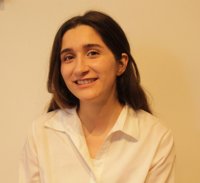 Khatereh Roohi is a PhD student in the Corrosion Technology and Electrochemistry group of the Department of Materials Science and Engineering, Faculty of Mechanical Engineering, Delft University of Technology.
Khatereh Roohi is a PhD student in the Corrosion Technology and Electrochemistry group of the Department of Materials Science and Engineering, Faculty of Mechanical Engineering, Delft University of Technology.
Title: Rational Design of Cu-MOF Electrocatalysts for CO2 Reduction: A Pathway to Selective CO/Formate Production via in situ Raman Spectroscopy
Abstract*
The electrochemical reduction reaction of CO₂ (CO₂RR) to multi-carbon products is a promising technology to store intermittent renewable electricity in high-value-added chemicals and close the carbon cycle [1]. Its industrial scalability requires electrocatalysts to be highly selective to certain products, such as carbon monoxide or formic acid, which have the highest normalized market price among all other CO₂RR products [2, 5]. Many studies have proposed design strategies to overcome the modest selectivity of metal-based electrocatalysts, one of which is the structural tailoring of the electrocatalyst material through the introduction of organic ligands and the complexing of the ensemble [3]. In this regard, metal-organic frameworks (MOFs), with their structural tunability and easy fabrication methods, have shown promise as candidates for studying structure-influencing properties [4]. A substantial knowledge gap in CO₂RR still prevents the design of tailor-made materials, as the properties governing catalytic selectivity remain elusive. We aim to combine in-situ surface-enhanced Raman spectroscopy and density functional theory on Cu-MOFs-based electrocatalysts to unveil the reaction pathway for CO₂RR to a mixture of CO and formic acid. We observed that the coordination environment of metal catalytic sites influences the selectivity of the catalyst material. By identifying and tracking the critical intermediates and specifying the active sites, we can provide guidelines for the selectivity of CO/formate production on the surface of rationally designed MOF-based catalysts.
*In collaboratoin with Seyedamirhossein Mohseni Armaki, Arjan Mol, and Peyman Taheri (Corrosion Technology and Electrochemistry, TU Delft)
References
[1] Y. i. Hori. Electrochemical co2 reduction on metal electrodes. Modern aspects of electrochemistry, pages 89–189, 2008.
[2] M. Jouny, W. Luc, and F. Jiao. General techno-economic analysis of co2 electrolysis systems. Industrial & Engineering Chemistry Research, 57(6):2165–2177, 2018.
[3] J. Pérez-Ramírez and N. López. Strategies to break linear scaling relationships. Nature Catalysis, 2(11):971–976, 2019.
[4] P. Saha, S. Amanullah, and A. Dey. Selectivity in electrochemical co2 reduction. Accounts of chemical research, 55(2):134–144, 2022.
[5] C. Zhan, F. Dattila, C. Rettenmaier, A. Herzog, M. Herran, T. Wagner, F. Scholten, A. Bergmann, N. López, and B. Roldan Cuenya. Key intermediates and cu active sites for co2 electroreduction to ethylene and ethanol. Nature Energy, pages 1–12, 2024.
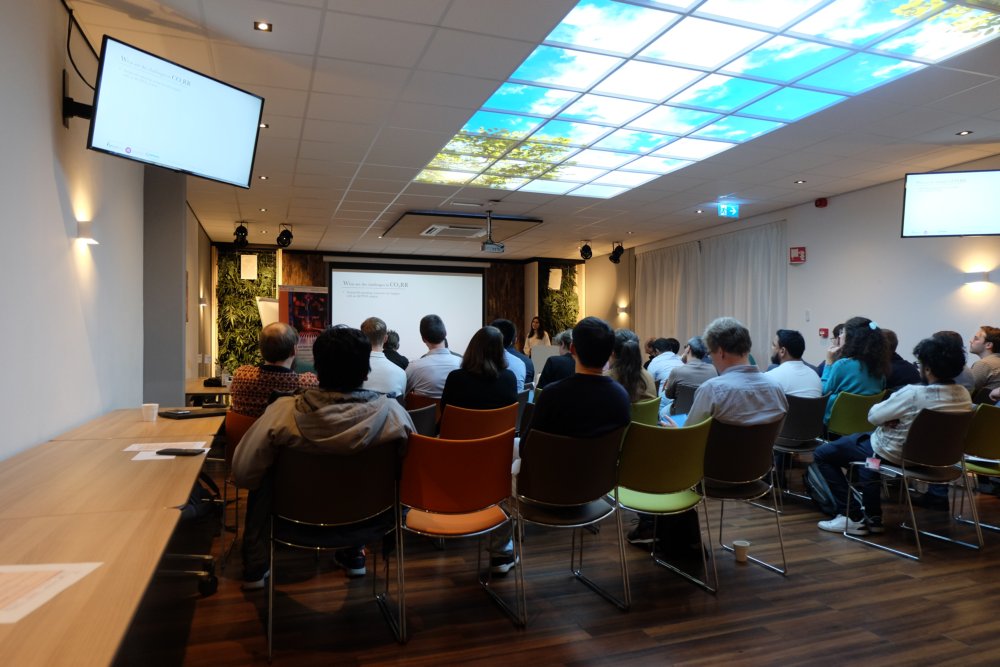
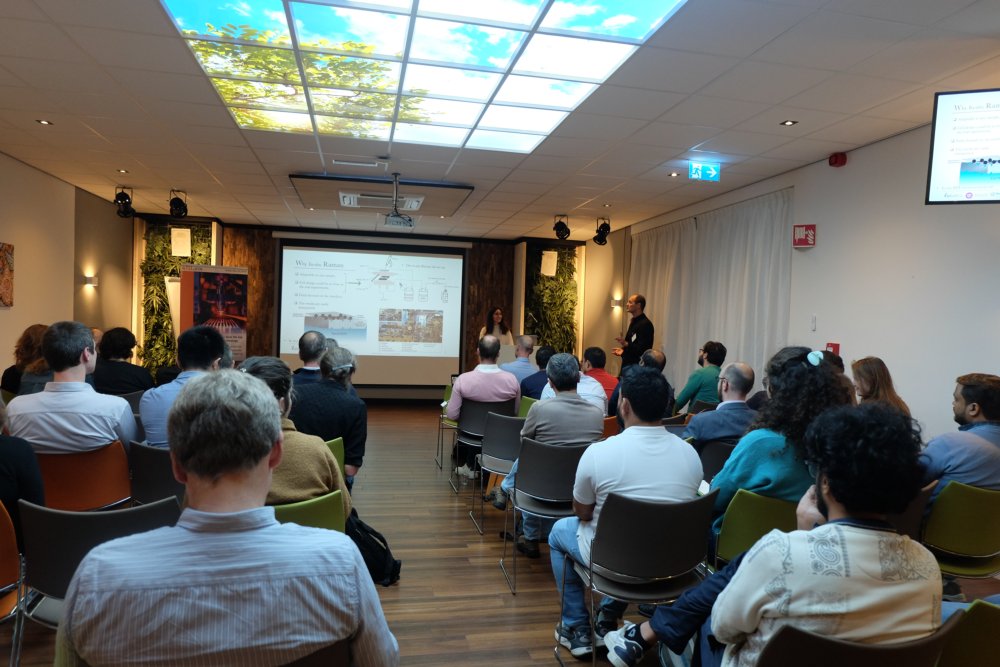
Stan Looijmans
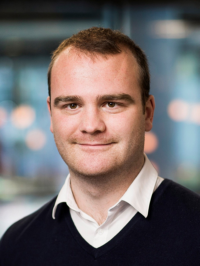 Stan Looijmans is an Assistant Professor in the Processing & Performance of Materials group at Eindhoven University of Technology
Stan Looijmans is an Assistant Professor in the Processing & Performance of Materials group at Eindhoven University of Technology
Title: Deformation kinetics of single-fiber polypropylene composites: adhesion improvement at the expense of toughness
Abstract*
Despite the maturity of the technology, processing of fiber-reinforced thermoplastic materials remains challenging, and difficulties in processability often result in material formulations with high modulus and strength, yet rather poor ductility compared to the pure polymer matrix. To gain fundamental insight into the deformation mechanisms present in such materials, the complexity of the system is stepwise increased; first, the effect of the most commonly applied adhesion enhancement, the addition of MAH-g-PP compatibilizer, on the bulk properties is assessed. The small-strain tensile properties, i.e., modulus and yield stress, appear to be only marginally affected by the addition of such compatibilization agent, however, the strain-at- break is strongly reduced, even before the addition of the fiber reinforcement [1]. Subsequently, using in-situ X-ray characterization methods upon tensile deformation, the time evolution of crystal structure and lamellar morphology is determined, and at first glance the compatibilizer addition appears to better preserve the crystalline structure. The onset of local failure (cavitation) is quantified at the interface of a single glass fiber. By increasing the adhesive interaction between fiber and matrix the stress concentration at the interface is increased, leading to an acceleration in void formation followed by unstable growth, which in turn strongly embrittles the composite. By the addition of various selective nucleating agents, it is demonstrated that the role of local phase composition and morphology on the deformation kinetics and subsequent failure mechanisms is much more pronounced than the increased adhesion between fiber and matrix by compatibilization or sizing effects. These findings may specify a new route toward tougher fiber-reinforced composites with reduced complexity in the material formulation.
*In collaboration with Hamid Ahmadi, Patrick D. Anderson and Lambèrt C.A. van Breemen (Processing and Performance, TU/e)
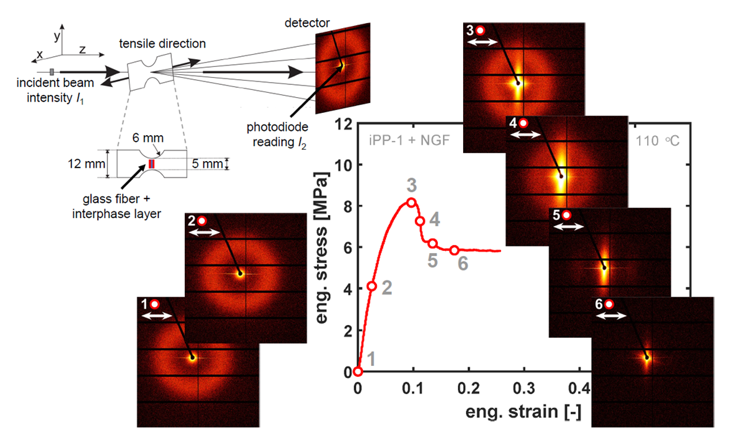
References
[1] Looijmans, S. F. S. P.; Ahmadi, H.; Anderson, P. D.; Van Breemen, L. C. A., Polymer 2023, 286 126374.

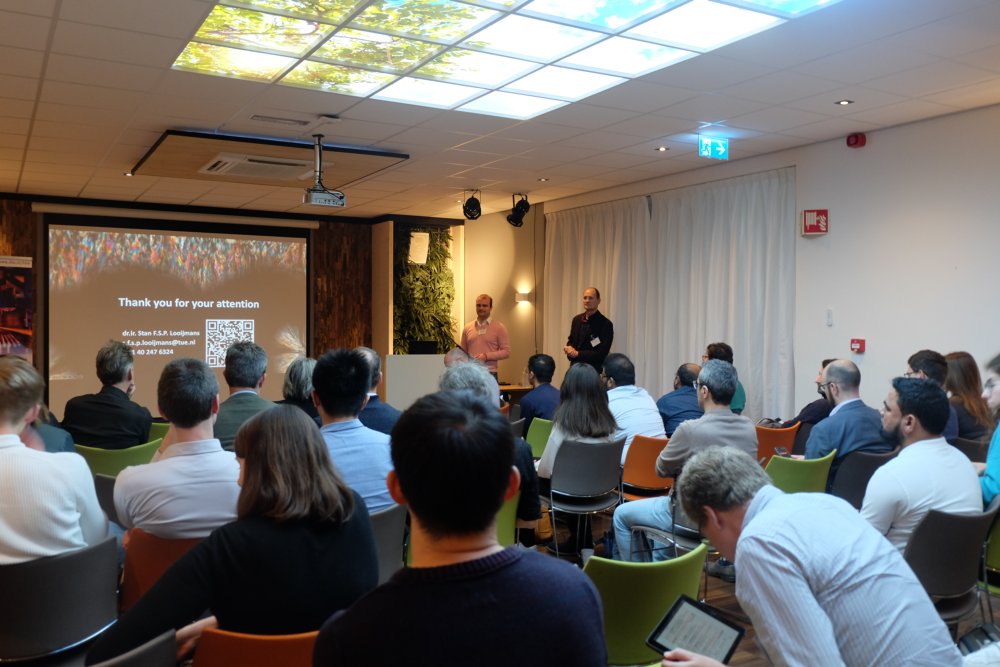
Sundar Raj Krishnaswamy
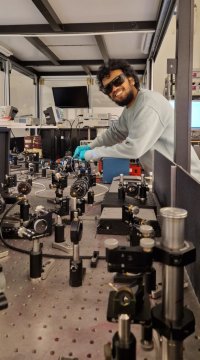 Sundar Raj Krishnaswamy is a PhD student in the Optical Condensed Matter Physics group of the Faculty of Science and Engineering, Zernike Institute for Advanced Materials, University of Groningen
Sundar Raj Krishnaswamy is a PhD student in the Optical Condensed Matter Physics group of the Faculty of Science and Engineering, Zernike Institute for Advanced Materials, University of Groningen
Title: Monitoring self-assembly of supramolecular nanotubes in real time
Abstract*
Molecular self-assembly, where molecules spontaneously organize into supramolecular structures, is a widely used bottom-up approach for creating nanostructures with examples including liquid crystals, light-harvesting complexes, and protein-based materials. Understanding the mechanisms behind these self-assembly processes is crucial for uncovering nature's efficient design principles. However, achieving this understanding is not feasible without integrating a variety of techniques, spanning from structural to functional methods.
Here we combine cryo-TEM, single-object optical microscopy, and advanced optical spectroscopy in a microfluidic setting to explore the self-assembly of supramolecular double-wall nanotubes, which are reminiscent of the natural light-harvesting antennae found in green sulfur bacteria. By utilizing a microfluidic setting, we map the timing of self-assembly onto a spatial coordinate to identify structure- property relationships under realistic dynamic conditions. Our findings suggest that nanotube formation starts with an inflated tubular structure, serving as a template for the outer nanotube's development. Overall, this study introduces a novel platform for real-time investigation of out-of-equilibrium self- assembly processes at both molecular and structural levels.
*In collaboration with Alexey Kuevda, Marc C.A. Stuart, and Maxim S. Pshenichnikov (Optical Condensed Matter Phyiscs, RUG)

Yuqiang Yang
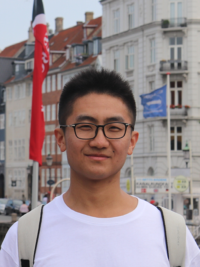 Yuqiang Yang is a PhD student in the Materials Chemistry group of the Zernike Institute for Advanced Materials, University of Groningen.
Yuqiang Yang is a PhD student in the Materials Chemistry group of the Zernike Institute for Advanced Materials, University of Groningen.
Title: Enhancing the Performance of NMC811 Cathode Materials through Surface Coating and Probed by Advanced Characterization Techniques
Abstract
NMC811 (LiNi₀.₈Mn₀.₁Co₀.₁O₂) is a highly attractive cathode material for lithium-ion batteries due to its high energy density and reduced reliance on the scarce and expensive cobalt. However, its practical application is limited by significant challenges, including structural degradation and capacity fading. These issues primarily arise from the instability of NMC811 in a highly delithiated state and undesirable side reactions between the electrolyte and the cathode. These interactions lead to irreversible capacity loss, particle spalling, and long-term performance degradation. To address these problems, we propose a surface coating strategy using a stable and conductive protective layer Li1.5Al0.5Ti1.5(PO4)3. The coating acts as a barrier, preventing electrolyte-induced degradation while maintaining ionic and electronic conductivity. The effectiveness of the coating in mitigating these issues is evaluated through advanced characterization techniques.
Operando X-ray Diffraction (XRD) is employed to monitor the structural evolution of the NMC811 material during cycling, revealing how the coating impacts the phase transitions and lattice stability under different states of charge. Cross-sectional Scanning Electron Microscopy (SEM) provided a detailed analysis of the morphology of both coated and uncoated cathodes, revealing morphological evolutions such as particle spalling and degradation before and after extended cycling. The results indicate that the surface-coated NMC811 exhibits improved capacity retention and reduced structural degradation, exhibiting a more intact and uniform structure. Notably, the coated cathode experiences significantly higher structural stability and fewer occurrences of particle spalling and surface cracking compared to the uncoated counterpart. These findings highlight the potential of surface coatings as an effective strategy to improve the long-term performance of NMC811 cathodes, while also emphasizing the critical role of advanced characterization techniques in evaluating material performance.



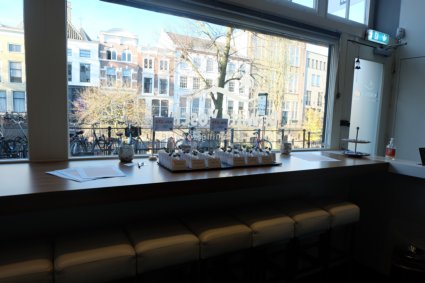
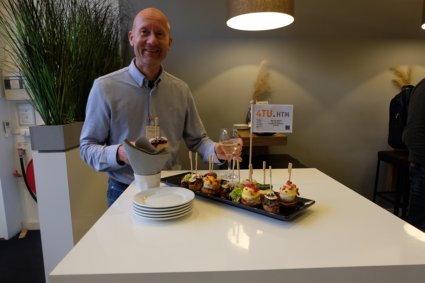


 This inspiring event took place at
This inspiring event took place at 